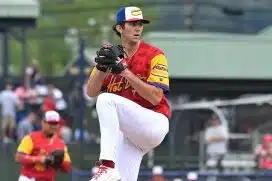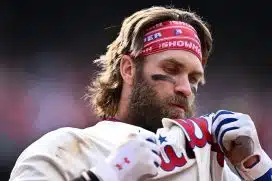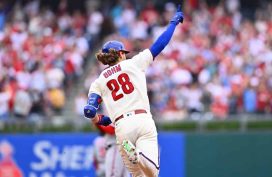By Tim Kelly, Sports Talk Philly editor
When you consider that Jeremy Hellickson has a 5.50 FIP in 2017 (per FanGraphs), the Philadelphia Phillies seem fairly lucky that the Baltimore Orioles, who don't seem to be serious playoff contenders, were willing to part with minor league reliever Garrett Cleavinger and international amateur signing bonus pool space as part of their return for the free-agent-to-be. That's about where their luck with Hellickson ends.
It's true, if you had told anyone on November 15, 2015 that Hellickson would post a 3.71 ERA over 189 innings in the 2016 season, they would have been elated. Heck, if you had told them that over the 52 starts that he made with the Phillies that he would go 18-15 with a 4.09 ERA, they would have been more than content.
But in general manager Matt Klentak's attempts to move the former American League Rookie of the Year, the team certainly didn't run into a ton of good luck.
Hellickson couldn't have been pitching better leading to the 2016 non-waiver trade deadline. In the month of July 2016, he was 3-1 with a 2.39 ERA over six starts. To make things even better, over 14 innings against the potential suitor Miami Marlins that month Hellickson allowed just six hits and one earned run.
Ken Rosenthal of FOX Sports reported this past offseason that the Marlins, who had been rumored to be in on Hellickson, had a trade on the table to acquire him after new pickup Colin Rea suffered an injury in his first start with the team. The trade would have allowed the Phillies to acquire first base prospect Josh Naylor, who was a top-10 prospect in the Marlins' depleted system:
The commissioner’s office offered the Marlins the opportunity to rescind the deal.
The Marlins, however, were under the impression that the commissioner’s office preferred them to seek a remedy from the Padres, sources said. That, ultimately, was the path the Marlins chose, sending Rea back to the Padres for pitching prospect Luis Castillo, who also was in the original deal.
The Marlins’ Plan B, if they had nixed the deal, was to trade Naylor to the Phillies for right-hander Jeremy Hellickson and market Castillo for a controllable starter before the Aug. 1 non-waiver deadline, sources said. The Phillies, sources said, had agreed on Hellickson-for-Naylor, only to lose out when the Marlins kept their deal with the Padres mostly intact, enabling Naylor to remain with San Diego.
Certainly, there were other teams interested in Hellickson, but not enough that they were willing to part with a prospect comparable to Naylor. So without a team willing to give up a serious return for Hellickson, it seemed like retaining him for the rest of the season and allowing him to eat innings for two months in a rotation that was full on young starters who had injuries/innings limits made the most sense.
In the offseason, they could then place a qualifying offer on Hellickson, which would allow them to net a compensatory pick if he left in free-agency or retain him if he accepted the one-year/$17.2 million offer. It felt like a win-win.
Once the qualifying offer was slapped on Hellickson, it seemed to end the chance that the Scott Boras client would get a long-term deal. After a strong 2016 season, it didn't seem impossible that a team would give Hellickson a deal in the neighborhood of four years and $56 million. But they weren't going to do that and give up a compensatory round pick for a pitcher that's a back-end-of-the-rotation starter on a good team.
Under the new qualifying offer system that will begin this offseason, Hellickson's free-agency may have gone differently. A team that signs a player to a contract over $50 million has to give up a second and a fifth-round pick if they are over the luxury tax threshold. If they are under, they would give up just a third-round pick. It's entirely possible a suitor for Hellickson would have tried to sign him to a four-year/$49 million to avoid having to give up any compensation, but it's more likely that the Phillies would have received draft compensation for Hellickson under the new system.
Trending: Do the Phillies wait too long to promote prospects?
Hellickson, of course, ended up accepting the team's qualifying offer after getting a chance to briefly explore the free-agent market. Even then, the Phillies appeared to be in a fairly similar situation to what they were a year prior. They had control of Hellickson for one year, he was still just 29 and they seemed to be in a position to either attempt to trade him again in July or try to work out a long-term contract to keep his then stabilizing presence in their young rotation.
Unfortunately, year two with the Phillies didn't work out as well for Hellickson.
From a traditional statistics perspective, he was great in April, going 4-0 with a 1.80 ERA. Unfortunately, as SportsTalkPhilly.com's Jason Ferrie wrote at the time, metrics such as strikeout rate, FIP and xFIP predicted that he could fall of a cliff after April. Despite groans from the anti-Sabermetrics crowd, that's exactly what happened.
Hellickson posted a 7.04 ERA in May, a 4.30 ERA in June and a 6.04 ERA in July. Clearly, that didn't help his trade value and it ended the early season discussion of whether Hellickson was someone worth keeping around for a few more years. It also left the Phillies without a stabilizing force in their rotation, which they badly needed with Clay Buchholz's season-ending injury, underperformance/an injury from Jerad Eickhoff and a disappointing first half from Vince Velasquez.
Bad luck happens sometimes in sports. In a world where the Marlins didn't have the commissioner's office in their ear, Hellickson may have been traded to Miami a year ago. If Hellickson had the same free-agent candidacy as he did a year ago under the new CBA, he may have gotten a long-term deal and the Phillies may have netted some sort of draft compensation. Instead, he stayed with the Phillies, and wasn't even effective for a bulk of his second season.
Perhaps the front-office should have better predicted both how Hellickon's market would develop and his 2017 regression. All things considered, though, they did walk away with a former third-round pick in Cleavinger and some extra money to play with. Certainly, things could have ended worse. The bad luck that the team had with Hellickson outlined in this article does make you wonder if they couldn't have ended a little better, though.







